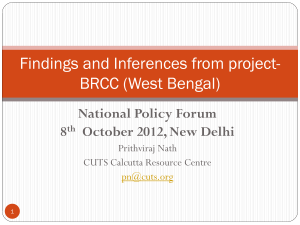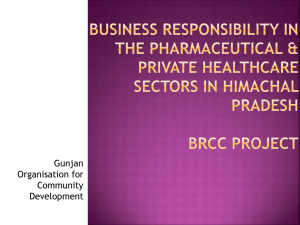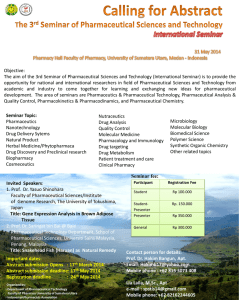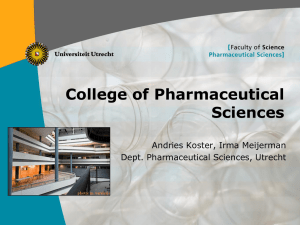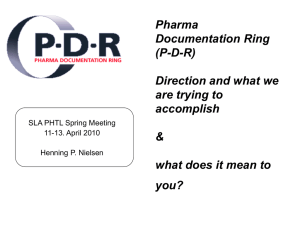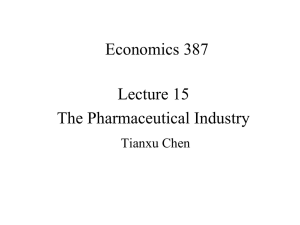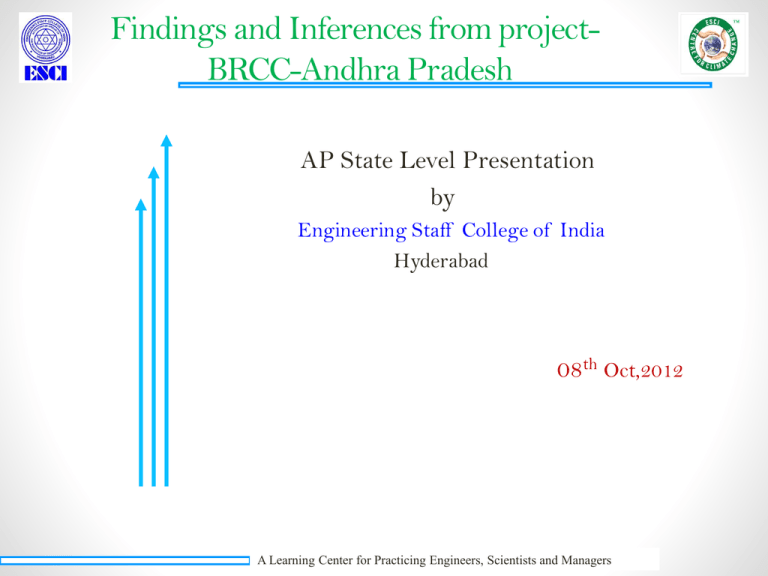
Findings and Inferences from projectBRCC-Andhra Pradesh
AP State Level Presentation
by
Engineering Staff College of India
Hyderabad
08th Oct,2012
A Learning Center for Practicing Engineers, Scientists and Managers
Overview - Pharmaceutical Sector In AP
•
Pharmaceutical Industry in India has history for more than 60 years.
•
Govt. of India has promoted Indian Drugs and pharmaceuticals Ltd. (IDPL) for bulk
drugs, injectables and medical devices.
•
IDPL has shown declining in the manufacturing activities from 1985.
•
Today ,in India, in general, the pharmaceutical industry is controlled by the private
sector.
•
The growth of pharmaceutical industry in Govt. of A.P has really taken momentum
from 1980 onwards.
•
In the state of A.P, the pharmaceutical industry has really grown and seen the
heights of achievement. Today, A.P. state is the bulk drug capital of India.
•
In the State of A.P. there are about 5,000 manufacturing units, out of which about
4,500 Active Pharmaceutical Ingredients (API) Manufacturing, about 300 drug
formulation units and about 200 other products.
Overview - Health Care Sector In AP
•Chief Minister of AP taken interest is developing of Health Care industry from 1983 onwards due to
their vision the following were introduced in the AP. Which released in the followings :
•Public-Private Medical Infrastructure > 3000 Hospitals (Public-Private), 12522-Sub Centers,
AUYASH Hosp-51, Blood Banks-286, Eye Banks-96. Med Colleges - 315/29263, Dental College289/21547.
•Hyderabad is emerging as a Medical Hub Center in South Eastern Area of India. Private Medical
Infrastructure- >300 Hospitals (Multispeciality-80, Superspeciality-15, Single Speciality-205) (Eye80,Dental-50<Ortho-25,Cardiac- 12, Diebetic-11, Neuro-1, Kidney-1, Cancer-25, other single
speciality-85). Large number of Cosmetic, Restructuring & Wellness Centers have come up. 1000015000 beds under private sector. Beds 1.75/1000 population.
•Other towns are also progressing towards stable medical centers in AP ; Visakhapatnalm/
Nellore/Vijaywada/Warangal/Guntur.
•Number of Hosp/ beds double- triple in public sector, private Health Care Equipment (HCE) have Bed
Occupancy Rate (BOR) 70-80% hence out perform public sector HCE.
Survey Covered in Pharma and Private Health Care Sectors
•
The survey covers 3 Zones;
Zone-I
:
Zone-II
:
Zone-III
:
Kakinada & Visakapatnam cities (Visakapatnam, East Godavari, West Godavari Districts)
Guntur & Vijayawada cities (Krishna, Guntur and Nellore , Prakasham districts)
Hyderabad, Ranga Reddy, Medak and Mahaboob Nagar Dist.
Zones
Zone - I
Zone - II
Zone - III
Total
A) Pharmaceutical Sector
a) Large Scale Industries
17
---
09
26
b) Medium Scale Industries
10
19
10
39
c) Small scale Industries
----
10
20
30
Sectors
Additional information
e) API’s units
84
f) Formulation Units
07
g) Others
04
B) Private Health Care Sector
a) Private Hospitals
28
31
19
78
b) Prescriptions
62
100
65
227
Macro level findings in Pharmaceutical Sector
•The large except few small scale industries do comply with current Good Manufacturing Practices
(cGMP) requirements to the required level meeting with the stringent requirements from domestic
and International customers for the supply of quality product on continuous basis.
•Pharmaceutical industry representing Govt.of A.P have really taken the challenges as
opportunities to contribute significant growth in the overall Gross Domestic Product (GDP).
•The pharmaceutical industry of Govt.of A.P is struggling hard with commitment to fulfill the
stringent environmental regulations framed by Ministry of Environment and forest (MOEF),
monitoring of the implementation is being carried out by APPCB in association with the central
pollution control board (CPCB) guidance and directions.
•The common disposal of waste from small to medium organizations through these common
treatment plants is not only a great relief but also justified for huge capital investment otherwise
required.
•The manufacturing of drug products and distribution to ultimate customers (human beings) as
required is generally being carried out through marketing net work and medical representatives in
the front line.
•The every organization’s target to maximize sales and increase customer base with an ultimate
aim to achieve maximum profit while gaining the product reputation in the market and establish
the product brand.
Macro level findings in Private Health Care Sector
•Noncompliance regulatory norms.
• Most of the health care units in different municipal areas do not have a proper Bio Medical
Waste Management system.
•BMW Management is done mostly through agreement with competent practices and state PCB
is very rigid and strict about the enforcement of BMW. All the hospitals are aware about BMW
management and handling rules.
•The professionals formulate regulations to operate private nursing homes and hospitals.
Otherwise, the government will have to participate in laying down guidelines, directives or
regulations to ensure quality care.
• There is lack of continuous medical education programmes for healthcare providers. A
continuous education programme for physicians may be introduced to improve quality care.
• CSR is a good concept. But the organizations or business enterprises is not ready to
implement because it involves direct and indirect cost. It needs a dedicative approach to
perform CSR not only one angle that is business and profit.
•The National Voluntary Guidelines not understood and followed by the many people involved
in Health Care Industry.
Survey Findings in Pharmaceutical sector
• Overall
Good Manufacturing
Practices
(GMP)
understanding
level and
implementation to the required regulatory requirements in Zone-I & Zone-III
sectors is almost about 80 to 85% satisfactory level. About 15 to 20 %, though
understanding is fairly satisfactory found gap in the implementation. This
observation is mostly applicable in the small to medium scale industries.
• In Zone-I and Zone-III sectors, the information reveals that, the practices that are
being currently followed is about 50% satisfactory level only.
• In Zone-II sector, the information reveals that, the practices that are being currently
followed is about 30% satisfactory level only.
• The poor environmental management practices implementation from small to
medium scale industries is mainly due to financial constraints.
Survey Findings in Pharmaceutical sector
• Currently, there are about 10 industries started implementation of Corporate Social Responsibility
(CSR) activities in the respective surrounding localities.
• The CSR programmes currently under implementation are sponsoring programmes to promote
education, to improve sanitary and hygiene environments, health camps etc,.
• The population covered under survey for manufacturing of pharmaceutical drug products is only
about 10%.
• All the industries manufacturing pharmaceutical drug products did express that the distribution of
drug products through medical representatives (MR’s) is the right channel.
• The Distribution of drug products by MR’s through their regular visits to Doctors, Chemists,
Hospitals administration management and through electronic media.
• Majority of the industries feel that the sales and marketing activity is purely proprietary and not
interested to disclose the actual practices.
• The Pharma industries in the state of A.P have obtained highest no. of US Food and Drug
Administration (USFDA) and other regulatory approvals and continue to maintain the lead.
• The pharma sector, from State of A.P contributes more than 25% of the turn over of the total
pharma sector turnover from Govt. of India.
• To improve the current environmental management practices, is a major concern.
Figure (A): No. of Pharmaceutical units in Andhra
Pradesh (30%)
Zone
Location
Industry
Type
Zone I
Vizag
Employme
nt status
Medium to
25,000 to
Large
30,000
Guntur,
Small to
9,000 to
Krishna
II
Medium
10,000
and West
Godavari
districts.
Zone- Hyderabad, Small to
35,000 to
Rangareddy medium
III
40,000
, Medak
and Large
and
scale
Sangareddy
districts
Table 1: Nature and status of Pharma sector in the
state of Andhra Pradesh
Zone-
Figure (B) : Industries surveyed in three zones
Turnover
status
8,000 to
10,000
crores
500 to 700
crores
15,000 to
16,000
crores
Fig. (C) : Different types of environmental problems in three zones
Survey findings in Pvt. Health Care Sector
Prescription Analysis :
Total Prescriptions-227.No diagnosis, No age/sex, no Generic drugs
prescription.
ZONE-I(62)
ZONE-II(100)
ZONE-III(65)
• Male
23
46
33
• Female
33
43
30
• No Gender
0
07
02
• No Diagnosis
36
47
14
• Illegible Prescription
76
56
19
• Not in Therapeutic
26
59
03
Drugs Index.
• Antibiotic- 55 Prescriptions, Analgesics- 34 Prescriptions, Vitamins/Tonics32 , PPI -34 , H2 Blockers-23.
• Per Prescription cost Rs 332.00 its on higher side & of costly drugs for 392
prescription. Total value Rs 1,34,090.00
Survey findings in Pvt. Health Care Sector
Prescription Analysis :
• 150 patients purchased drugs from Hospital Pharmacy, 78 patients purchased from
outside pharmacy.
• In 133 prescriptions Lab Investigations has been done from Hospital Lab, 93 Lab
investigations done from outside .In 63 lab prescriptions indicate facility is good
in hospital whereas 130 prescription indicated outside labs facility are good.
• 1-2% prescriptions have asked Imaging Diagnostics.
•
Most irrationally prescribed drugs were:
i) Multiple Antibiotics Pro-biotic Used Along With most of the Antibiotics.
ii) Non-Steroidal Anti-Inflammatory Drugs, arthritis (NSAIDs)
iii) PPI & H2 blockers used along with all Analgesics .
iv) Vitamins used with Antibiotics
v) Medication with no diagnosis is an irrational prescription/ drugs not in Therapeutic
Index/Illegible Prescription also an Irrational Prescription( Medication error high).
vi) No banned drugs were prescribed.
Survey findings in Pvt. Health Care Sector
1. 14- CBMWTF in AP
2. BMW Rules- 60% Optimal,10%-Needs
Improvement, 4% Regulatory Authorities to see,
16% Nil comments, 2% others.
3. Quality Assessment of BMW in Hosp. 52%
Yes, 48% No.
4. Challenges in QA of BMW:35% Lack of
awareness , 20% Segregation, 10% Storage
Problem, 10% In situ Treatment, 10% High Cost of
Treatment/Handling,4% Irregular Service by the
waste collection vendor, 11% Lack of Funds.
5. Suggestion on BMWM;45% Training by SPCB,
25% Hospital need to be proactive , 10%
BMWM/ Environment
Department
be
made,10% others , 10% Champion HK on
BMWM.
6. CSR Policy; 90% private HCI are aware . Large
Hosp 100%,Medium Hosp 90% , Small hosp-10%.
7. CSR Practices; Large Hospitals; 60% It increase
good will,20% its social responsibility, 20% Its
business need.
Medium Hospitals; 50% Its for goodwill, 40%
Social Responsibility,10% Business need.
Small Hospitals; 30% For Goodwill, 40% Social
Need,20% Business Need , 10% others
8.Regulations,Compliances,Awareness- 87% follows
Code of Conduct. 70% says it improves the services &
trust among patients.
9. Code of Medical Ethics,2002;90% are aware, 10%
needs further improvement.
10. UCPMP; 62% are aware.
11.NVG;70% are aware.
12.STP;70% are aware.
13. RUD;60% Yes it exists , 25% no , 15% No
response.
14. Prescription Guidelines; 40% yes, 30% No , 30%
no response.
15. Compliance Mechanism; 10% yes , 80% No ,10%
Nil Response.
16.Prescription Audit; 60% yes , 15% no, 25% Nil
Response.
17.Salary; 42% Fixed , 26% Pay per case , 32% FP +
Case based fee.
18. Unethical Behavior;
Commercial Motives of Drs-24%
Incentive by Pharma-16%
Weak regulatory System-20%
Role of Pharma Associations-5%
Role of Hospital Associations-3%
Role of MCI-4%
Role of Hospitals-4%
Others-24%
Figure A- Hospital Beds in Zones I,II & III
Figure B – No. of private hospitals surveyed in Zones I,II & III
Figure C – No. of Prescriptions collected in Zones I,II & III
Recommendations - Pharmaceutical Sector
• To improve upon the GMP practices and environmental management practices in the
pharma sector (Which is mandatory), has to be promoted by frequent free training
programmes from state and central drug department personnel to enlighten the need and
depth of these requirements.
• Environmental pollution caused by the pharma industry and the associated negative
impacts on the society in general, the surrounding localities in particular is an un-ending
and un-resolved issue. May be Govt.of India, with revised industrial policies may insist
and implement strictly by not promoting the creation of housing colonies with in the
vicinity of the industries at any cost.
• Govt.of India, may control and provide the critical resources such as, coal, water, power
and land at affordable prices to make small to medium scale industries viable and
healthy. Upon creation of such a healthy environment, Govt. as well as local NGO’s and
voluntary organisations can insist to contribute their mite for social cause to up lift the
society for better living and social status.
•
The current un-quantified and un-specified un-ethical practices in the marketing
distribution chain, if identified and eliminated in a positive perspective can result in
affordability for a common man for better health.
• The associations and NGO’s do feel that Govt. should recognize such bodies as
arbitrators to create a conducive environment between industry, regulator and Govt.
authority.
• The associations should voice out on critical issues facing by the industry such as
power, VAT increase, coal etc,. to reduce the in put cost with an expectation to arrive a
possible solution to the problem.
Recommendations – Pvt. Health Care Sector
• Self Regulation by Private Hospital on all the issues of Triple Bottom.
• Hospital Associations to be proactive & supportive , to ensure Private Health Care
Equipment (HCE) is more responsible - inclusion of business responsibility clauses in
the mandate of associations and periodic assessment with facilitation from Ministry of
Corporate Affairs
• Civil Society Organisations and community should take it as their civic responsibility
towards monitoring , ethical & environmental concerns, spread awareness, rules, for
common consumers.
• Compliance protocol on recognising their business responsibility as part of the core
business activity and creating incentives for adopting the same.
• Capacity building of private HCI on voluntary guidelines – charting a sector specific
roadmap
• Policy directions by Stakeholders & regulators is a binding on HCI & be strictly
applied , non clinical staff need to be empowered as clinicians are involved with
patients. HCI should have their own policies based on domain documents. it should
be read & signed by all functionaries.
• Protocol of pre training of out sourced HK staff for handling of BMW. Service
provider to ensure , a regulation be made.
Recommendations - Pvt. Health Care Sector
• Department of Environment be made in Hospitals they should do In house
monitoring/ control / training / reporting etc.
• System of Award-Reward for best performers also staff following good practices
also be rewarded.
• Lab/Other area Liquid Waste Disposal & Soiled Linin management be strictly put in
place.
• Mutilation of Sharps , crushing of Expired drugs & mutilation of plastic in hospital
be must.
• Use of biodegradable bags for store/carriage of BMW.
• In place of colored bag, a colored patch be put to minimize Volatile Organic
Compound (VOC).
• Chemists should only stock drugs not other items, half shop stock Generic Drugs.
More shops on generic. Media should educate masses on Generics.
• All silver catch cover of drugs should have permanent imprint of Date of
Manufacture (DOM)/Date of Expiry (DOE) / batch No/Maximum Retail Price
(MRP) & not ink print. It will help reuse of expired drugs.
• HCI must understand the business module of CSR rather than only conducting
charity camps.
THANK YOU
Engineering Staff College of India
Gachibowli
Hyderabad, AP
Email: ccc@escihyd.org / ccc.esci@gmail.com

